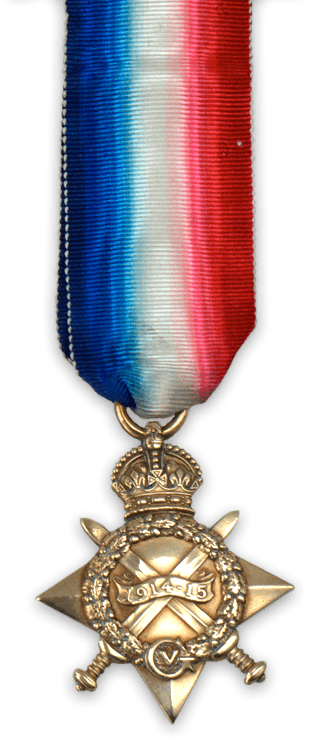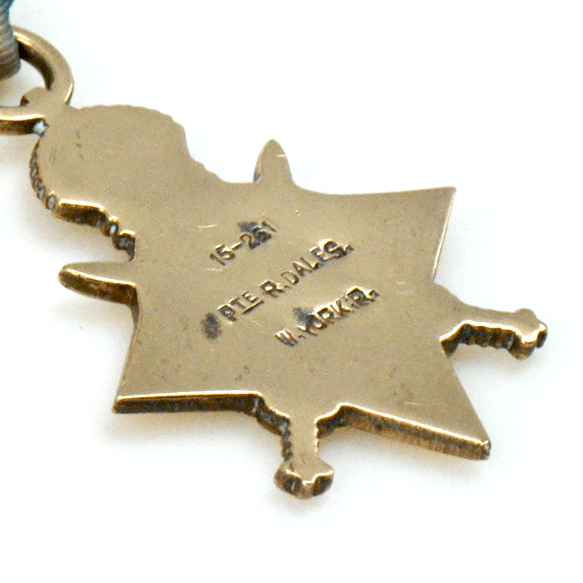1914-1915 Star
King George V felt very strongly that those who fought early in the First World War should be awarded medals to reflect this service. The first was the 1914 Star, which was awarded to people serving on the Western Front in France from 4 August to 22 November 1914. The majority were awarded to soldiers who had been in the army before war was declared.
The 1914-1915 Star was produced as the result of a long newspaper campaign. People who had fought in 1914, but not in France felt it was unfair they did not have a specific award. This upset was shared by people who fought in similarly difficult campaigns in 1915. It was awarded to people who fought in any theatre of war from 23 November 1914 to 31 December 1915. Many of the volunteers who fought in this period may have belonged to Pals battalions. The 1914-1915 Star was always awarded as part of a group with the British War Medal and the Victory Medal.


Ribbon View
The ribbon is blue, white and red, reflecting the colours of the flag of Great Britain.

Suspension View
The suspension is a simple ring, which folds the ribbon and links it to the medal. This type of suspension means that the ribbon often frays because of the wear and tear the clasp puts on it.

Obverse View
The medal is a four-pointed star, but the topmost point is covered with a crown. The star is overlaid with a laurel wreath and crossed Roman swords. A scroll is in front of the swords showing the years 1914-1915. Below the scroll are the letters G and V - they form the monogram of George V.

Reverse View
The naming of the awardee is on the reverse of the Star. These details were impressed by machine.
Features View
The medal is made from bronze.

1914-1915 Star
King George V felt very strongly that those who fought early in the First World War should be awarded medals to reflect this service. The first was the 1914 Star, which was awarded to people serving on the Western Front in France from 4 August to 22 November 1914. The majority were awarded to soldiers who had been in the army before war was declared.
The 1914-1915 Star was produced as the result of a long newspaper campaign. People who had fought in 1914, but not in France felt it was unfair they did not have a specific award. This upset was shared by people who fought in similarly difficult campaigns in 1915. It was awarded to people who fought in any theatre of war from 23 November 1914 to 31 December 1915. Many of the volunteers who fought in this period may have belonged to Pals battalions. The 1914-1915 Star was always awarded as part of a group with the British War Medal and the Victory Medal.
-

Ribbon
The ribbon is blue, white and red, reflecting the colours of the flag of Great Britain.
-

Suspension
The suspension is a simple ring, which folds the ribbon and links it to the medal. This type of suspension means that the ribbon often frays because of the wear and tear the clasp puts on it.
-

Obverse
The medal is a four-pointed star, but the topmost point is covered with a crown. The star is overlaid with a laurel wreath and crossed Roman swords. A scroll is in front of the swords showing the years 1914-1915. Below the scroll are the letters G and V - they form the monogram of George V.
-

Reverse
The naming of the awardee is on the reverse of the Star. These details were impressed by machine.
-
Features
The medal is made from bronze.